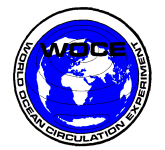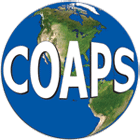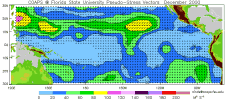




Since many areas of the tropical oceans do not have sufficient ship and buoy data to sample the monthly fields adequately, the other three methods are thought by many scientists to be preferable. Sufficient data for monthly fields, in the tropics, is generally believed to be a minimum of 30 observations in a 2° latitude by 10° longitude region (Luther and Harrison (1984); Halpern (1988); Legler (1991)). Only the wind scatterometers promise to meet this requirement. Low-level cloud data are also sparse over the tropics, particularly due to the lack of satellite coverage in large regions of no low clouds or excessive high clouds. General circulation model (GCM) results look promising, but it has been shown that these give poor performance in the tropics, leading to poor surface stress analysis (Lambert and Boer (1988), McPhaden, et al. (1988a); McPhaden, et al. (1988b)).
Programs in the U.S. and France prepare analyses of wind stress fields for the tropical ocean regions. Florida State University (FSU) produces wind stress analyses for the Pacific and Indian Oceans. Dr. J. Servain, Orstom, Brest, produces analyses for the tropical Atlantic Ocean. This atlas represents 20 years of FSU results for the tropical Pacific. Results for the Indian Ocean can be found elsewhere (Legler, et al. (1989); Stricherz, et al. (1993)).
The history of this Pacific winds project is interesting. Klaus Wyrtki binned tropical Pacific wind data from ships for the period prior to 1970 (Wyrtki and Meyers (1975); Wyrtki and Meyers (1975)). They used 2° x 10° boxes for each month and eliminated high winds over 40 ms-1. In the mid-seventies, several people suggested that equatorial oceanic Kelvin waves were responsible for initiating El Niño's (Wyrtki (1975); Hurlburt, et al. (1976); McCreary (1976), etc.). Since oceanographers had never observed these giant Kelvin waves, the theory was dismissed by many as wrong. In order to convince the scientific community, the Mesoscale Air Sea Interaction Group at Florida State University subjectively analyzed the monthly Wrytki-Meyers data onto a 2°x2° grid for 1961-1970 (O'Brien and Goldenberg (1982)) and used it to simulate the El Niño's for 1963, 1965, and 1968-1969 (Busalacchi and O'Brien (1981)).
For the 1970's data, the NORPAX project collected the tropical Pacific Ocean wind data at Scripps. Dr. Steve Pazan provided FSU with the binned data on the previously used 2° x 10° grid. The analysis results (Legler and O'Brien (1985)) were used to continue the FSU Pacific Model (Busalacchi, et al. (1983)) to simulate the occurrence, timing and relative amplitude of the 1972 and 1976 El Niño's.
After the 1982-1983 El Niño, the U.S. TOGA Project Office funded FSU to prepare "quick-look" wind stress fields and run an experimental El Niño Forecast Model (Inoue and O'Brien (1984); Inoue and O'Brien (1986)). For the study, we analyzed monthly tropical Pacific winds for the period 1981-1985 but used individual marine reports available through the National Climate Data Center (NCDC) instead of the already binned data.
These tropical Pacific pseudostress data have been used by many other TOGA investigators to investigate various aspects of the interannual wind stress field over the Pacific and the results of ocean models driven with these winds. In order to provide a more homogeneous product, it was decided to reanalyze the 1965-1980 period using the Comprehensive Ocean-Atmosphere Data Set (COADS, Slutz, et al. (1985)) CMR5 data (individual ship reports) as is currently done.
We have compared our climatology with the Hellerman and Rosenstein (Hellerman and Rosenstein (1983)) climatology. They compare very well within 20° of the equator using a drag coefficient of 1.7 x 10-3 and an air density of 1.2 kg m-3. At higher latitudes the non-linear drag coefficient used in the Hellerman and Rosenstein climatology results in higher stresses.
The individual wind vector data in the tropical Pacific region,30°N to 30°S, 120°E to 70°W, typically 25,000 observations monthly, are first converted to pseudostress. (A pseudostress vector is defined as the wind components multiplied by the wind magnitude). A pseudostress vector of 60 m2s-2 corresponds to 1 dyne cm-2 assuming a drag coefficient of 1.4 x 10-3 and an air density of 1.2 kg m-3).
These pseudostress vector components are then binned into 10° longitude by 2° latitude rectangles. In each rectangle with more than two observations, statistical theory is used to eliminate bad observations. For each rectangle with greater than two observations but less than 11, the lowest and the highest component values are ignored. For locations with greater than 10 reports the top and bottom 10% are removed for each stress component.
New averages are then computed and a three-standard-deviation test is used to eliminate any remaining outliers. The resulting scalar fields are then subjectively analyzed and checked by trained meteorologists. After digitization, the resulting 2° by 2° grid is given a final examination and checked for errors.
Fields of the anomaly from the 32 year (1961-1992) mean month are also produced. This data is used at Florida State University to drive a numerical model (see Busalacchi and O'Brien (1980), Busalacchi and O'Brien (1981)) producing estimates of the upper ocean currents in the tropical Pacific. It is also used in predicting the occurrence of El Niño events (Inoue and O'Brien (1984); Inoue and O'Brien (1986)).
Each spring, a more complete set of marine reports is obtained from NCDC for the previous year. This set contains data already received via GTS and supplemental reports that were received late. The increase in the number of observations in the tropical Pacific regions is about 10-25%. The analysis procedure is the same for this more complete data set, and the results constitute the "research quality" product.
Internet: winds@coaps.fsu.edu
Telephone:
(850) 644-4581
(850) 644-4841 FAX
US Mail:
Center for Ocean-Atmospheric Prediction Studies
The Florida State University
Tallahassee, FL 32306-2840
U.S.A.
Stricherz, J., D. M. Legler, and J. J. O'Brien, 1993: Atlas of Florida State University Indian Ocean Winds for TOGA 1970-1985, Florida State University, Tallahassee, FL, 250 pp.
Further information on WOCE-MET Web pages can be obtained by mailing: wocemet@coaps.fsu.edu.
Last Modified: Tue, 12 Nov 2013